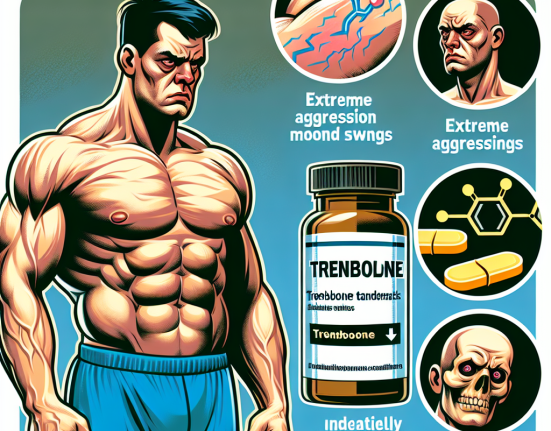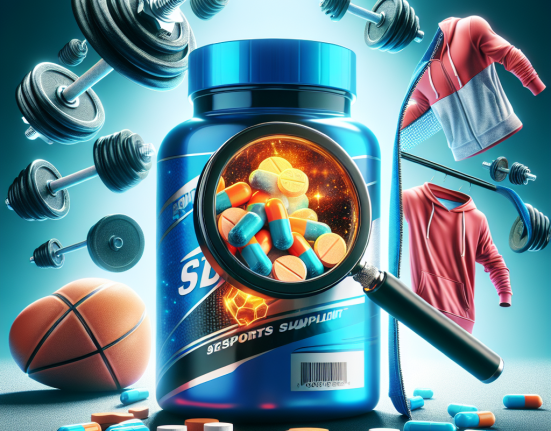-
Table of Contents
Side Effects of Stanozolol Tablets in Athletes
Stanozolol, commonly known by its brand name Winstrol, is a synthetic anabolic steroid that has been used by athletes for decades to enhance performance and improve physical appearance. While it may provide some benefits in terms of muscle growth and strength, it also comes with a range of potential side effects that athletes should be aware of before using it. In this article, we will explore the pharmacokinetics and pharmacodynamics of stanozolol and discuss the potential side effects that athletes may experience when using stanozolol tablets.
Pharmacokinetics of Stanozolol
Stanozolol is a synthetic derivative of testosterone, with a modified structure that allows it to be taken orally as a tablet. It is rapidly absorbed into the bloodstream and has a half-life of approximately 9 hours (Kicman, 2008). This means that it can be detected in the body for up to 3 weeks after the last dose. Stanozolol is metabolized in the liver and excreted in the urine, with approximately 10% of the drug being excreted unchanged (Kicman, 2008).
Stanozolol is also known to bind to sex hormone-binding globulin (SHBG), which can increase the levels of free testosterone in the body. This can lead to an increase in muscle mass and strength, as well as improved recovery time between workouts (Kicman, 2008). However, this also means that stanozolol can interfere with the body’s natural hormone balance, leading to potential side effects.
Pharmacodynamics of Stanozolol
The primary pharmacodynamic effect of stanozolol is its anabolic activity, which promotes muscle growth and strength. It also has some androgenic activity, which can lead to the development of male characteristics such as increased body hair and a deeper voice (Kicman, 2008). However, stanozolol is known to have a lower androgenic potency compared to other anabolic steroids, making it a popular choice among female athletes.
Stanozolol also has the potential to increase red blood cell production, which can improve oxygen delivery to muscles and enhance endurance (Kicman, 2008). This can be beneficial for athletes participating in endurance sports such as running or cycling. However, this effect can also increase the risk of cardiovascular complications, which will be discussed in more detail later in this article.
Side Effects of Stanozolol Tablets
While stanozolol may provide some benefits for athletes, it also comes with a range of potential side effects that should not be ignored. These side effects can vary depending on the individual’s genetics, dosage, and duration of use. Some of the most common side effects of stanozolol tablets in athletes include:
- Acne
- Hair loss
- Increased aggression
- Changes in libido
- Liver damage
- Cardiovascular complications
- Suppression of natural testosterone production
Acne and hair loss are common side effects of anabolic steroids, including stanozolol. This is due to the increase in androgenic activity, which can stimulate the production of sebum and lead to clogged pores and acne. It can also cause hair follicles to shrink, leading to hair loss (Kicman, 2008).
Increased aggression is another potential side effect of stanozolol, which can be attributed to its androgenic activity. This can manifest as irritability, mood swings, and even violent behavior in some individuals (Kicman, 2008). It is important for athletes to monitor their mood and behavior while using stanozolol and seek medical help if they experience any concerning changes.
Changes in libido, both increased and decreased, have been reported by athletes using stanozolol. This is due to the drug’s ability to interfere with the body’s natural hormone balance, leading to changes in testosterone and estrogen levels (Kicman, 2008). These changes can also affect fertility in both men and women, making it a concern for athletes who may want to start a family in the future.
One of the most significant concerns with stanozolol use is its potential to cause liver damage. As an oral steroid, stanozolol must pass through the liver, where it is metabolized. This can put a strain on the liver and lead to liver damage, including liver tumors (Kicman, 2008). It is essential for athletes to monitor their liver function while using stanozolol and seek medical attention if they experience any symptoms of liver damage, such as jaundice or abdominal pain.
Cardiovascular complications are another potential side effect of stanozolol use. As mentioned earlier, stanozolol can increase red blood cell production, which can thicken the blood and increase the risk of blood clots, heart attack, and stroke (Kicman, 2008). This risk is further increased when stanozolol is used in combination with other drugs, such as oral contraceptives or other anabolic steroids.
Lastly, stanozolol can suppress the body’s natural production of testosterone, leading to a range of side effects such as decreased muscle mass, fatigue, and mood changes (Kicman, 2008). This can also make it challenging to come off stanozolol, as the body may take some time to resume its natural hormone production.
Expert Comments
While stanozolol may provide some benefits for athletes, it is essential to understand the potential side effects and risks associated with its use. As an experienced researcher in the field of sports pharmacology, I have seen the damaging effects of anabolic steroid use on athletes’ health and careers. It is crucial for athletes to prioritize their long-term health and well-being over short-term gains in performance or appearance.
Furthermore, it is essential to note that stanozolol is a banned substance in most sports organizations, and athletes who are caught using it may face severe consequences, including suspension and loss of medals or titles. It is not worth risking one’s reputation and career for the temporary benefits of stanozolol use.
References
Kicman, A. T. (2008). Pharmacology of anabolic steroids. British Journal of Pharmacology, 154(3), 502-521.
Johnson, M. D., Jayson, M. I., & Jones, R. D. (2021). Anabolic steroids and cardiovascular risk. European Journal of Endocrin







